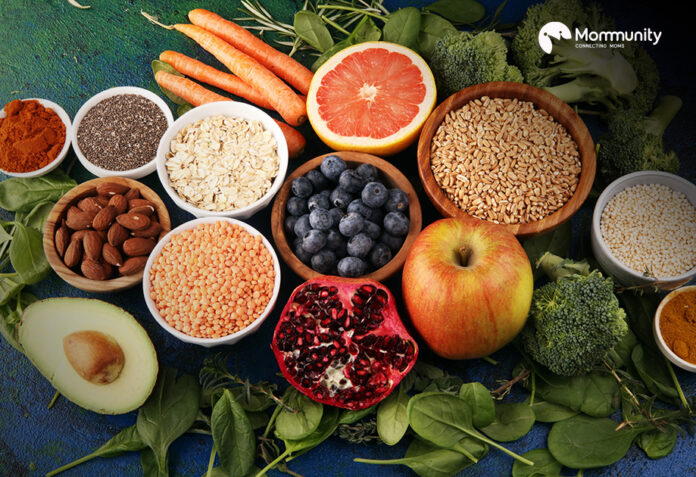Is your baby feeling tummy trouble? Are you getting worried? But don’t worry this is due to a lack of high-fiber foods. Fiber plays an important role in promoting healthy digestion and preventing constipation in babies. A common issue in babies and toddlers. Most of the parents are worried about how to cure but it’s easy to cure in babies.
In this blog, we will learn more about high-fiber foods that help in preventing constipation in babies. So, let’s dive deep into the blog.
Why Include Fiber in Your Baby’s Diet?
Fiber helps to keep the digestive system flowing by helping to move solids through the intestines. It also helps in maintaining a healthy weight and can prevent childhood obesity by providing a feeling of fullness. For babies, incorporating fiber-rich foods can make sure they start on the path to a balanced diet.
Safe Introduction of Fiber to Babies
Before incorporating high-fiber foods into your baby’s diet, it’s important to make sure they are ready for solid foods. Usually, babies are ready to start solids around six months of age, but it’s always best to consult with your pediatrician. Start with small amounts to see how your baby’s digestive system handles the fiber.
Top 10 High-Fiber Foods for Babies
Here’s a list of great high-fiber foods to incorporate into your baby’s meals:
1. Pears
Pears are a gentle laxative and a great source of fiber. They can be easily pureed for babies and are generally well-accepted due to their sweet flavor.
How to Serve
Steam and puree pears for a smooth texture or mash them if your baby is a bit older and can handle more texture.
2. Peas
Peas are not only high in fiber but also protein, which is beneficial for your baby’s growth.
How to Serve
Blend cooked peas into a smooth puree for younger babies or mash them lightly for older infants.
3. Broccoli
Broccoli is rich in fiber and nutrients like vitamin C and iron. It’s ideal for babies who are ready for a variety of tastes and textures.
How to Serve
Steam and puree, or offer small, soft-cooked florets to babies practicing finger foods.
4. Lentils
Lentils pack a lot of fiber and protein and can be introduced as part of a balanced diet as your baby starts eating a variety of solid foods.
How to Serve
Cook lentils until soft and offer as a puree or as part of a thicker mash with vegetables.
5. Whole Grain Cereals
Whole grains like barley, quinoa, and oats are excellent sources of fiber. They also provide essential nutrients like iron and B vitamins.
How to Serve
Choose single-grain cereals and cook them until soft; mix with breast milk, formula, or water to get a smooth consistency.
6. Apples
Apples are a fiber-rich fruit that can help to regulate your baby’s digestion. They are also high in vitamin C.
How to Serve
Peel, cook, and puree apples for a smooth apple sauce. For older babies, grated raw apple is suitable.
7. Sweet Potatoes
Sweet potatoes are not only high in fiber but also vitamin A, which is important for your baby’s vision, skin, and immune function.
How to Serve
Bake or steam sweet potatoes and puree or mash them depending on your baby’s texture preference.
8. Avocado
Avocado is a fiber-rich food that also provides healthy fats, important for your baby’s brain development.
How to Serve
Mash avocado with a fork until smooth, or cut into small pieces for baby-led weaning.
9. Prunes
Prunes are well known for their ability to help alleviate constipation. They are high in fiber and natural sugars.
How to Serve
Offer prune puree mixed with other foods if its taste is too strong for your baby on its own.
10. Carrots
Carrots are another baby favorite that provides fiber and beta-carotene, important for eye health.
How to Serve
Steam and puree carrots for a smooth consistency or provide cooked sticks that babies can hold and munch on.
The Final Note
Introducing high-fiber foods into your baby’s diet is a main step in making sure their digestive health and overall well-being. From the gentle purgative properties of pears to the rich nutrient content of broccoli and lentils Each food mentioned above offers unique benefits that can help keep your baby’s tummy happy and support their growth and development. As you begin to integrate these fiber-rich foods into meals, remember to start with small quantities and observe how your baby reacts to each new addition.
It’s also important to maintain a varied diet that includes a balance of nutrients, as fiber is just one part of a healthy dietary puzzle for your little one. Always consult with your pediatrician before making significant changes to your baby’s diet, especially when introducing solid foods around six months of age.
With the right approach and knowledge, you can make mealtime both enjoyable and nourishing for your baby, setting them up for a lifetime of healthy eating habits. Remember, every baby is different, so tailor your food choices to their needs and preferences, and watch as they grow strong and healthy with each fiber-filled bite.




